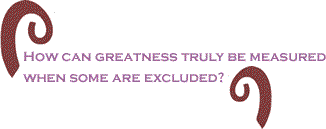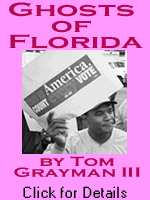
I was extremely pleased when
I read the list of players selected for the NFL’s 2005 Pro Bowl. For the first time
in NFL history, all the quarterbacks for a Pro Bowl Team, in this
case the NFC, are black: Duante Culpepper, Donovan McNabb and Michael
Vick (making Rush Limbaugh eat crow – well, more like Jim Crow).
However, my celebration was short-lived as I began to reflect on
the history of blacks and sports in America. I have always been a student
of sports (especially football). I have studied the record books
of the “Big
Three” of sports (baseball, basketball and football) and some
people have considered my knowledge of these encyclopedic – or
annoying, depending on who you ask. Anyhow, the one thing that
I have found extremely interesting in my studies is the asterisks
next to certain records. There was an asterisk next to Roger
Maris’s old single season homerun record, calling attention to
the fact that his 61 homeruns were obtained in a 162 game season
and Babe Ruth’s 60 occurred in 154 games. I have seen asterisks
next to the names of Eric Dickerson, Barry Sanders, Terrell Davis
and Jamaal Lewis because they surpassed 2000 yards rushing in
a 16 game season, whereas the original 2000 yard rusher, O.J.
Simpson, accomplished this feat in 14 games. There was even an
asterisk next to the name of Otto Graham when he was still amongst
the top ten of the NFL’s all-time quarterbacks a couple of years
ago. The notation for the asterisk stated that if the records
from the All American Football Conference (a football league
that briefly rivaled the NFL from 1946 to 1949 – the two leagues
merged in 1950) were counted then his place among the NFL’s all-time
passers would have been higher. (Although, on the official website
for the NFL’s Hall of Fame, they have recently recognized his
AAFC statistics – as a result he now stands at No. 6 all-time).
So as you can see, there is an asterisk for just about everything.
However, I began to think
about all the places where asterisks should appear and don’t. With Barry
Bonds closing in on Major League Baseball’s all-time homerun
record and the NFL’s postseason well under way, I thought of
those who were never afforded the opportunity to make their mark
or realize their full potential. I speak not of Lou Gehrig, Sandy
Koufax, Gale Sayers and Reggie Lewis or of any of the great athletes
whose careers were cut short by an injury or unforeseen tragedy,
but of those individuals such as Josh Gibson, Warren Moon and
Leroy “Satchel” Paige (and many more) whose full greatness was
never completely realized because of discrimination and bigotry.

For example, the name of
Josh Gibson is seldom or never mentioned when speaking of the
single season
and career home run records. (And when Barry Bonds had the “audacity”  to
insinuate that Josh Gibson was a greater slugger than the American
Institution Babe Ruth, sportswriters across America let him have
it with both barrels). In various publications, the 6-foot-1,
215-pounder has been credited with as many as 84 homers in one
season. His Hall of Fame plaque says he hit “almost 800” homers
in his 17-year career. His lifetime batting average was higher
than .350, with one book putting it at .384, best in Negro League
history. Gibson died of a stroke at the age of 35 in 1947 (three
months before Jackie Robinson’s debut with the Brooklyn Dodgers)
without ever receiving the opportunity or credit his talent deserved.
Alas, there will never be an asterisk next to Babe Ruth’s legend. to
insinuate that Josh Gibson was a greater slugger than the American
Institution Babe Ruth, sportswriters across America let him have
it with both barrels). In various publications, the 6-foot-1,
215-pounder has been credited with as many as 84 homers in one
season. His Hall of Fame plaque says he hit “almost 800” homers
in his 17-year career. His lifetime batting average was higher
than .350, with one book putting it at .384, best in Negro League
history. Gibson died of a stroke at the age of 35 in 1947 (three
months before Jackie Robinson’s debut with the Brooklyn Dodgers)
without ever receiving the opportunity or credit his talent deserved.
Alas, there will never be an asterisk next to Babe Ruth’s legend.
African-American college
quarterbacks, for the longest time, were either ignored altogether
or, when
an opportunity came, got one shot. When they weren’t immediate
sensations – and quarterbacks rarely are, black or white – they
were shifted to traditionally “black positions,” (running back,
defensive back and receiver) where their “natural athleticism” (old
school NFL language for “black”) would serve them better. “As
a black QB, they are constantly trying to switch you to another
position,” said James Harris in 1974, when he was the lone black
NFL starting quarterback, playing for the Los Angeles Rams. His
success was short-lived. “Blacks get two types of opportunities
to play quarterback in the NFL: a chance and a ‘nigger’ chance," says
Harris. "One mistake and you were gone.” The long-held belief
in the intellectual and social inferiority of African-Americans
was the foundation that prevented and limited opportunities.
(The comments that Rush Limbaugh made concerning Donovan McNabb,
just a year ago, tells us that traces of these beliefs still
linger).

Warren Moon, one of the most prolific
passers in NFL history (the most in Professional Football
when his CFL statistics are considered) had to begin his career
in Canada because of the bigoted notions of many in the NFL during
this time. When Moon graduated from Washington, black quarterbacks
in the NFL were rare and generally unsuccessful. Willie Thrower,
Marlin Briscoe and Joe Gilliam had tried before him. Doug  Williams
was treated like a trailblazer when he was chosen in the first
round by Tampa Bay in 1978. A few teams, particularly in the
South, probably feared a fan backlash as well. So Warren was
urged to become a running back or a safety. At 6'3", 210-lbs.,
he had the right size for either one; but he refused. He wanted
to be a quarterback and when he was not chosen in the draft (which
lasted 12 rounds back then), Warren signed with the Edmonton
Eskimos of the CFL. He soon won five league titles. In NFL career
passing statistics, Warren Moon is: 3rd in attempted
passes, 5th in total touchdown passes, 3rd in
total passes completed and 3rd in total yards passing.
Where would he stand in the annals of NFL history had he not
been discriminated against? We are left only to guess without
a single asterisk to guide us. Williams
was treated like a trailblazer when he was chosen in the first
round by Tampa Bay in 1978. A few teams, particularly in the
South, probably feared a fan backlash as well. So Warren was
urged to become a running back or a safety. At 6'3", 210-lbs.,
he had the right size for either one; but he refused. He wanted
to be a quarterback and when he was not chosen in the draft (which
lasted 12 rounds back then), Warren signed with the Edmonton
Eskimos of the CFL. He soon won five league titles. In NFL career
passing statistics, Warren Moon is: 3rd in attempted
passes, 5th in total touchdown passes, 3rd in
total passes completed and 3rd in total yards passing.
Where would he stand in the annals of NFL history had he not
been discriminated against? We are left only to guess without
a single asterisk to guide us.
Satchel Paige did not reach
the majors with the Cleveland Indians in 1948 until he was in
his forties.
Before that time it is reported he pitched 50 no-hitters and
surpassed Cy Young (Major League Baseball’s winningest pitcher,
with 511 wins) in games won. Sure the baseball aficionados pay
homage to Paige now, but where is his name in Major League Baseball’s
all-time records book? Where would it be had it not been for
institutional and systemic racism? Cy Young’s legendary status
remains unchallenged and yes – no asterisk. There is not adequate
space or time to name all who have eaten the bitter fruit of
racial discrimination in sports. For now these examples will
have to do.

Some might say that we
will never know, so why bother? Others are quick to cite people
such as Doug Flutie
not getting a fair shake because of his height (or some other
obscure or insignificant factor) – as if height discrimination
should have equal footing with slavery and Jim Crow. ( The NAAVC – The
National Association for the Advancement of the Vertically Challenged?
Nah… Doesn’t work for me either).
I fully realize that life
is filled with unanswered questions. That is one of the more
interesting
characteristics about sports, the all-consuming “what if.” What
if Bill Buckner would have snagged that grounder? What if Sandy
Koufax would have played longer? What would happen if the 1972
Dolphins played the 1985 Bears? What if the Portland Trailblazers
would have selected Michael Jordan with the 2nd pick instead
 of Sam Bowie, in the 1984 NBA Draft? What if Len Bias wouldn’t
have died of a drug overdose? I am not disturbed by not knowing,
but by the reason we do not know. The reason we do not know is
ugly, hideous and unworthy to be counted amongst the attributes
of a society that claims to be a shining example of fairness
and equality. Imagine this scenario: I am teacher in a class
room and I’m administering a test to determine who the best student
is. For no good reason, I exclude five students from taking this
test. When the test is completed (by those who had been allowed
to take it) I raise the hand of the student with the highest
score; and in the presence of the excluded students I proclaim
this student to be “the best.” Now, by this gesture, what am
I saying about greatness? What am I saying about equality? of Sam Bowie, in the 1984 NBA Draft? What if Len Bias wouldn’t
have died of a drug overdose? I am not disturbed by not knowing,
but by the reason we do not know. The reason we do not know is
ugly, hideous and unworthy to be counted amongst the attributes
of a society that claims to be a shining example of fairness
and equality. Imagine this scenario: I am teacher in a class
room and I’m administering a test to determine who the best student
is. For no good reason, I exclude five students from taking this
test. When the test is completed (by those who had been allowed
to take it) I raise the hand of the student with the highest
score; and in the presence of the excluded students I proclaim
this student to be “the best.” Now, by this gesture, what am
I saying about greatness? What am I saying about equality?
I know there are some who
may say that by my writing this article I am implying that legends
such as
Babe Ruth, Dan Marino, John Elway, Ty Cobb or Cy Young have not
achieved or are not deserving of greatness. Nothing could be
further from the truth. I too have marveled at their exploits
(ESPN Classic is must see T.V. in my home). I call not into question
their achievements, but the designations of “greatest” and “best.” As I further pondered
this issue of prominence achieved by way of exclusion, I
began to think about my educational experience as a student.
I rarely, if ever,
heard the words “greatest” and “best” used in reference to a
woman (the closest I’ve come to hearing it was with Amelia Earhart
when she was called, not the greatest pilot, but the greatest “female” pilot).
Not in my history, social studies or English classes. And I suppose
that is the heart of the matter for me. How can greatness truly
be measured when some are excluded? How absolute is the portrait
of achievement when the colors we use to paint it are incomplete?
Discrimination and prejudice have a way of obscuring true achievement
and call into question our ideas about “greatest”…“unsurpassed”…“best.”
I humbly dedicate this composition to all whose dreams were not
thwarted by a lack of talent, skill or determination, but by narrow
minds and intolerant hearts. Cheers and asterisks to you. |






